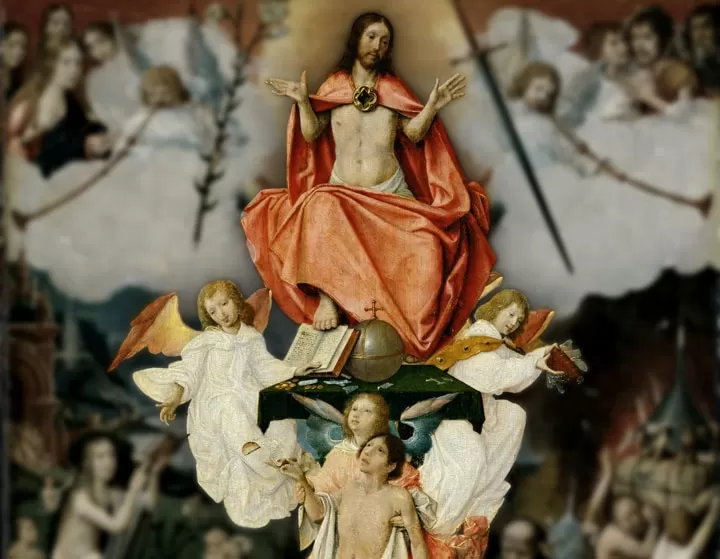
Cosmological renewal is mostly a metaphor in the Bible for the restoration of the people of God after catastrophic divine judgment—first, the Babylonian invasion and the exile, then the destruction of Jerusalem and the temple by Rome in AD 70. But I think that the resurrection of Jesus was a real event, not merely a symbol for the “resurrection” of Israel, and that it introduces an ontological novelty into the narrative that will find fulfilment in the real—not metaphorical—remaking of heaven and earth, of which John speaks in Revelation 21:1-8. The key point here is that the reign of the resurrected Jesus in heaven, at the right hand of God, was always meant to culminate in the defeat of the last enemy, death (1 Cor. 15:24-28). So John says that not only the wicked but also “Death and Hades” are thrown into the lake of fire to be destroyed (Rev. 20:14).
But we may then ask the question: who will benefit from this? Or to use the symbolic language of Revelation, whose names are written in the “book of life”? I suggest that there are three distinct groups.
1. Some first century Jews expected, on the basis of Daniel 12:1-3, a partial resurrection of righteous Jews, and perhaps of some unrighteous Jews, at the time of the restoration of Israel after an intense crisis of oppression and apostasy. In apocalyptic Christian thought this became the “first resurrection” of the martyrs following the long, traumatic witness of the churches against pagan Roman imperialism (Rev. 20:4-6). If you are curious to know when and how this happened, see this post. There is no resurrection of the wicked at this juncture.
It is specifically this first resurrection, as vindication of faithful witness and adherence to vocation in the face of persecution, that was unexpectedly anticipated in the singular resurrection of Jesus (cf. 1 Cor. 15:20-23). Conversely, the premature resurrection of Jesus was understood to guarantee the resurrection of the martyrs, who refused to worship the beast, who conquered death, and who now reign with Christ throughout the thousand year period from the overthrow of Babylon the great, which is beastly Rome, to the final judgment of all the dead. Their names have been written in the Lamb’s book of life (Rev. 3:5; 13:8; 17:8; cf. Phil. 4:3).
2. The resurrected martyrs serve as “priests of God and of Christ” in the New Jerusalem that is in heaven. But there are two visions of the holy city in Revelation 21. In the second vision the city descends into the present creation as a symbol of the presence of God in the midst of the nations, which walk by its light and are continually healed by the leaves of the trees that grow beside the river that flows from it… (Rev. 21:22-22:5).
Nothing “common” nor those who engage in idolatrous and false worship (poiōn bdelygma kai pseudos) will be permitted to enter this city, “only those who are written in the Lamb’s book of life” (Rev. 21:27). I take this to be a reference to the servants of God and the Lamb throughout history, at least insofar as they did not engage in idolatrous and false worship. Their names are recorded in the same book that has the names of the martyrs, which will be brought out at the final judgment, for which they will be raised among the “rest of the dead” (Rev. 20:5, 12). “Christians,” therefore, don’t go to heaven when they die. They are dead until the final judgment.
3. There are several books opened at the last assize (cf. Dan. 7:10)—perhaps books recording the deeds of the righteous and unrighteous, but also “another book…, which is the book of life” (Rev. 20:12). Whether this is the same as the Lamb’s book of life is unclear. But this is a judgment according to works, after a “second” resurrection of all the dead. Nearly all humanity stands before the great white throne. The martyrs are presumably excluded: their heritage will be the new heaven and new earth because they have conquered, because they triumphed over opposition and death (Rev. 21:7). They have already been justified by their faithfulness.
Those whose names are not written in the book of life—“the cowardly, the faithless, the detestable, …murderers, the sexually immoral, sorcerers, idolaters, and all liars”—are destroyed in the lake of fire, which the “second death” (Rev. 20:15; 21:8). The wages of sin, ultimately, is death, not eternal conscious torment. But I think we may infer that a section of humanity, distinct from those who serve as a priesthood of God and of the Lamb in the temple-free holy city on earth (that is, the church), will be judged worthy of the life of God’s new creation because they have done good works. This is Paul’s argument about divine approval of righteous Greeks, when the Greek-Roman oikoumenē is judged, scaled up to the whole of humanity.
I’m curious about whether or not you think the two resurrections we read about in Revelation was a fairly common first-century belief. Do we know of any other sources for this?
Outside of Revelation, it seems to me all the other Bible writers saw resurrection as a one-time event with the NT writers specifying it would happen at the return of Christ.
@Peter:
That would take a bit of work. I think that there is evidence in the Jewish literature of the period for the distinction that I make between three horizons—judgment of Israel, establishment of rule over the nations, and some sort of cosmic renewal. Off the top of my head, though, I can’t be specific about resurrection.
But I agree, the leading thought is of a resurrection in connection with the “coming” of the Son of Man or the parousia, which are “political” events. John’s idea of a resurrection of all the dead, not merely of Israel’s dead, and a final judgment appears as something of a novel development.
Recent comments